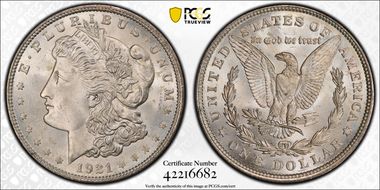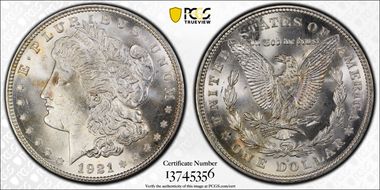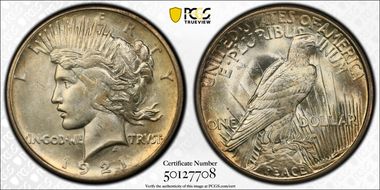Edward M. Paterson III (1921-2003) 的钱币相册
An unnecessary coinage: The coinage of Morgan silver dollars in 1921 was accomplished under the provision of the Pittman Act of April 23, 1918, which mandated that hundreds of millions of older silver dollars be melted down into bullion, and that the government should take the proceeds and buy new silver for a price of $1 per ounce, a considerable premium over current market levels. This was a sop to Western silver mining interests. While the Bland-Allison Act of 1878 and the Sherman Silver Purchase Act of 1890 mandated the purchase of unneeded, unwanted silver bullion at current market price, the Pittman Act dictated that the government pay considerably more than market. As usual, American taxpayers bore the brunt of the effect. There was little interest at the Mint in the recoinage program, and it was deemed expedient to resurrect the old Morgan design for further use. The earlier hubs had been destroyed in 1910, when no-body expected any further coinage of Morgan dollars. Morgan (with help from J.R. Sinnock) made copy hubs based on an 1878 7 Tailfeathers PAF, but in shallower relief and much poorer quality. Apparently, the original hubs had been destroyed or were deemed unfit for use, so new transfer hubs were made, these being of shallower relief and much poorer quality that those used during the earlier era. Numismatic Information Commentary: In 1921, the Mint redesigned the Morgan dollar. The new coin was in shallow relief with many features less well defined than on earlier (1878-1904) issues. Comparison of a 1921 Morgan dollar (from any of the three mints) with an issue from the early 1900s will show many differences. On the obverse of the 1921, the portrait of Miss Liberty is very shallow, and the cheek is almost flat; the lines of her hair are bolder and better defined; and there is no crease above her chin, among other distinctions. On the reverse of the 1921, the eagle is flat with virtually no breast feather detail, the arrow feathers are parallel (copied after an 1878 7 tail feathers, parallel arrow feathers, reverse), and the stars are slightly larger. In 1910, six years after the last coinage, the Engraving Department at the Philadelphia Mint believed that the days of the Morgan dollar were gone forever, and old hubs were destroyed. When the order came in 1921 to rush production of more Morgan dollars, new hubs were made by George T. Morgan and John R. Sinnock, but in shallow relief in order to facilitate quantity striking in a hurry. It was realized that one thing the world needed was not more silver dollars, and that most would simply go into storage (where countless millions of earlier dates already were in moldering bags). There was no need to consider aesthetic appeal.
1921 is the last year in which the Mint struck Morgan Silver Dollars. The coins were struck from the large and famous Nevada Silver discovery, the Comstock Lode. The 1921-D Morgan Dollar is also the only Morgan Silver Dollar that was struck at the Denver Mint. Despite being the last year of the Morgan Dollar it is also the only year in which you can obtain an example from each three different Mints. Which are the 1921 Philadelphia, Denver and San Francisco Morgan Dollars. Commentary: The 1921-D Morgan dollar is distinctive as the only Denver Mint coin of this design. A set of Morgan dollars from the different mints included Philadelphia, Carson City, New Orleans, San Francisco, and, now, Denver. The D mintmark is tiny on all issues; Micro D. Some coins were struck from die(s) with the D shallowly impressed; the mintmark is scarcely visible. In keeping with Philadelphia Mint coins, 1921-D dollars were struck from redesigned shallow-relief dies. Hoard coins: Vast quantities of Mint State 1921-D dollars were released in the 1950s and early 1960s. The issue was considered common, and most dealers did not desire to buy them. Today, original mintsealed bags are few and far between, but the coins themselves are common. However, far fewer Mint State 1921-D dollars exist than do 1921 Philadelphia Issues. Circulated grades: In worn grades, 1921-D dollars are exceedingly common. AU coins are difficult to distinguish from MS-60. An estimated 1.5 to three million circulated pieces survive. Mint State grades: The typical Mint State coin is in lower grades such as MS-60, 61, or 62, and is an average strike, but some are well struck. As the dies were in shallow relief, a sharp strike is not as distinctive as one of the earlier 1878-1904 era. The surfaces are often frosty and lustrous, a point in their favor. As is the case with 1921 Philadelphia Mint Morgan dollars, a certified 1921-D is apt to have a poor aesthetic appearance. I suggest these estimates: MS-60 to 62, 750,000 to 1,500,000; MS-63, 200,000 to 400,000; MS-64, 50,000 to 100,000; MS-65 or better (per current interpretations), 10,000 to 20,000.
San Francisco Mint. Like the Philadelphia and Denver facilities, the San Francisco Mint was pressed into service to strike large quantities of new Morgan dollars in 1921. Coinage began on May 9, 1921. Numismatic Information Commentary: The 1921-S dollars, like the 1921-D coins, all have a Micro S mintmark. In B. Max Mehl's sale of the Alex J. Rosborough Collection, April 9, 1929, a 1921-S was catalogued as follows: "1921-S Microscopic S. AU. This specimen is one of the first 50 struck, secured by members of the Pacific Coast Numismatic Society." Apparently, such coins had no special surface quality apart from normal circulation strikes. Hoard coins: Dollars of this date and mint were scarce during the 1920s, for relatively few were released. This changed when quantities were paid out from storage at the San Francisco Mint at intervals from the 1930s through the 1950s. 1921-S dollars were little esteemed in their time, thus few original mint-sealed bags were saved. Not even casino operators and other silver dollar hoarders liked the 1921 Morgan from any of the three mints. Today, while individual coins are exceedingly common, bags of 1921-S are few and far between. The Redfield estate (1976) apparently had a partial bag. The Numismatist, December 1939, told of a recent release of 1921-S Morgan dollars: Morgan Type Dollar From San Francisco Mint: An interesting sight in the daily change around San Francisco recently has been the 1921 Morgan dollars in Mint or Uncirculated condition, some having just been released in that condition through the regular course of business. It is thought that possibly 10 to 15 million were melted under provisions of the 1942 Silver Act. In comparison to surviving 1921 Philadelphia Mint coins, 1921-S dollars are far more elusive than the respective mintage differences (approximately 2:1) would indicate. Circulated grades: In worn grades the 1921-S dollar is very common. An estimated two to four million survive. Mint State grades: The usually-seen Mint State specimen is very poorly struck, has abraded surfaces, and even if the lustre is rich (as it is on some), the high points of the design are apt to be dull. Fully struck, lustrous coins exist, are scarce, and when seen are apt to be bagmarked. Of the 1921-S, Wayne Miller noted the following: "This date is by far the worst of any Morgan dollar in terms of appearance. Most are a weak mushy strike." As is the case with other 1921 Morgan issues, grading interpretations for 1921-S are rather loose in comparison to earlier Morgan dollar dates. My population estimates are as follows: MS-60 to 62, 1,000,000 to 2,000,000; MS-63, 200,000 to 400,000; MS-64, 30,000 to 60,000; and MS-65 or better (per current interpretations), 2,000 to 4,000.
The 1921 Peace dollar is a very interesting and extremely important coin. It is, of course, the first year of issue for the Peace dollar series. Slightly over a million pieces were struck, a modest mintage for a silver dollar. But the 1921 was struck in very high relief, not unlike the 1907 High Relief $20 St. Gaudens. For many years the 1921 was not recognized as a separate type coin, although it clearly is such. The PCGS founders, along with the experts on the PCGS (and now PCGS CoinFacts) Board of Experts, confronted this lack of type coin recognition sometime shortly after the 1986 launch of PCGS. We all just start listing the 1921 as a separate type and the numismatic community soon followed suit. So the 1921 is now important as both the first year of issue (and one of the scarcer isuues) for the Peace dollar series, and as a very important one-year-only 20th century silver type coin. The 1921 is one of the scarcest Peace dollars in both circulated and mint state condition. In Gem condition it is scarce, but not quite as rare as some of the usually very weakly struck S Mints such as 1925-S and 1928-S which, because of strike, are very rare in Gem condition. Nevertheless, because of the high relief of the 1921, strike can definitely be a problem. The majority of mint state specimens show weakness in the central devices, i.e. Liberty's hair and the eagle's feathers. Well struck Gems are definitely the exception. Luster can vary on this issue. I have seen many that are white and quite frosty and I have also seen many that have a very satiny look. Toning is not uncommon and is light to heavy golden. Note that I am of the very strong opinion that any 1921 Peace dollar...indeed any Peace dollar...that has any rainbow colors (blue, red, green, etc) is absolutely artificially toned. While not very scientific, my approach to toning on coins is to remember the colors I saw in the 1960's and 1970's and if a new look appears, it's artificial to me. This is kind of an "old school" approach and I may be wrong, but unless you believe global warming has created new colors for coins, it just seems illogical to me that new colors would suddenly appear naturally on coins. Back to the 1921 Peace dollar...this is, in my opinion, one of the most important coins of the 20th century, and also one of the most beautiful.























